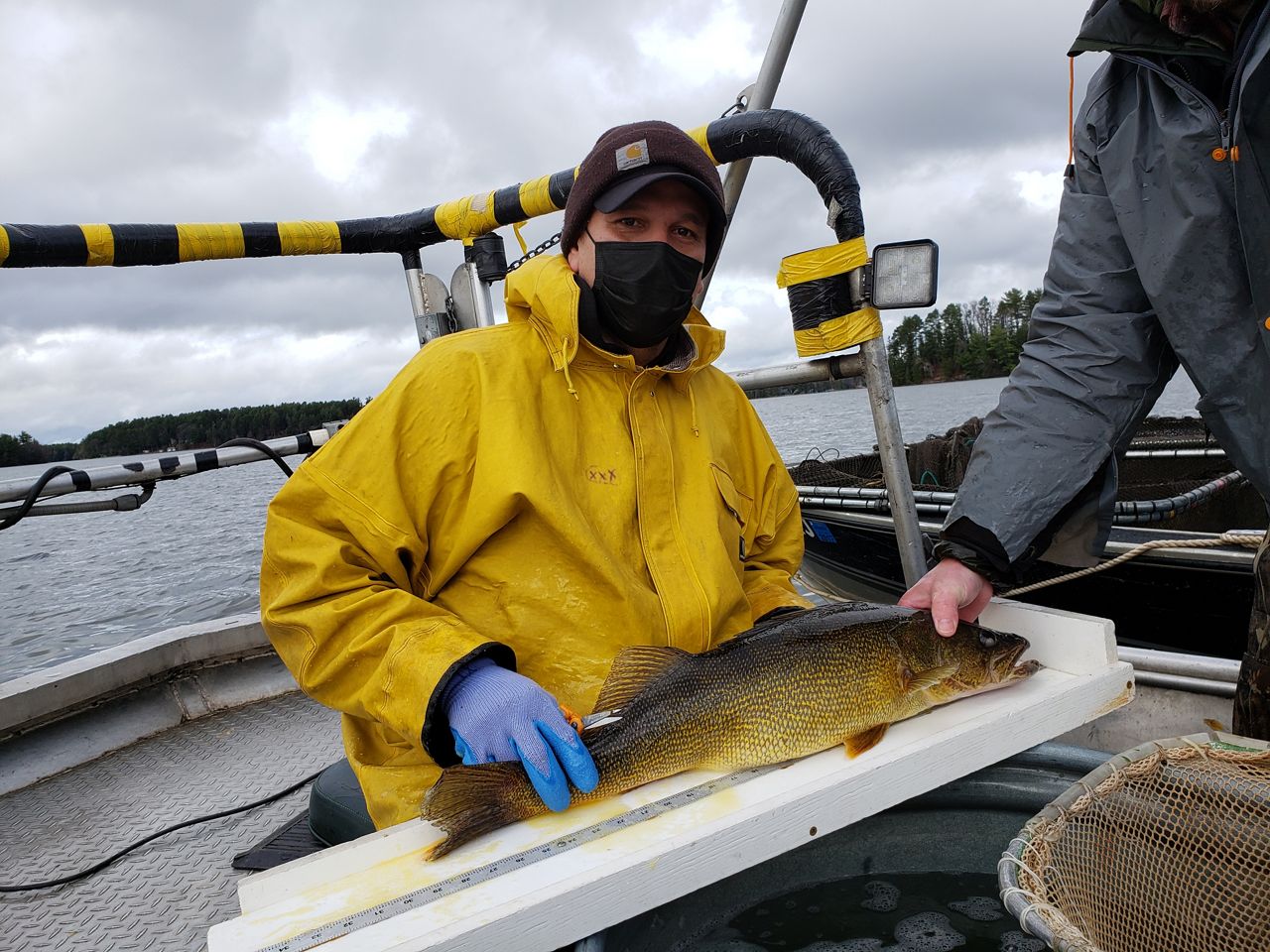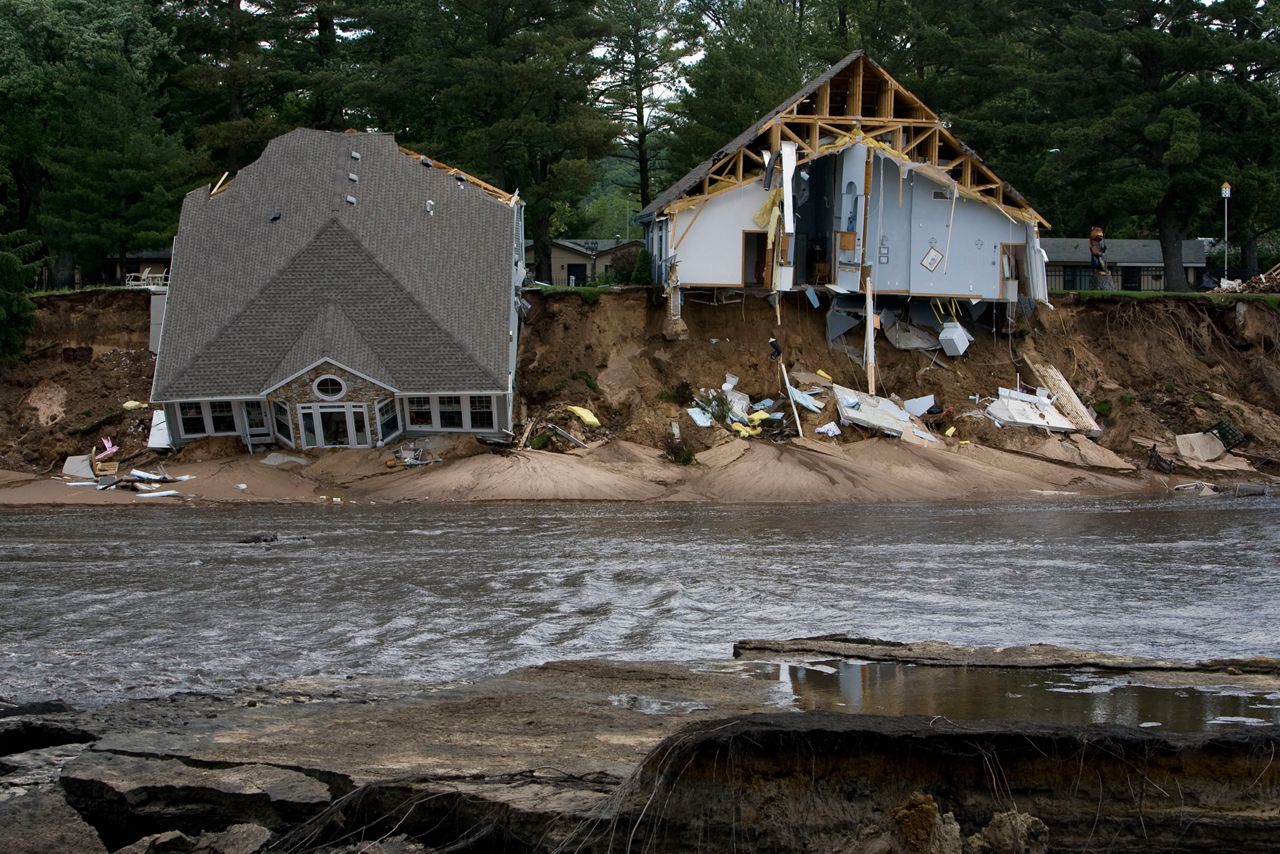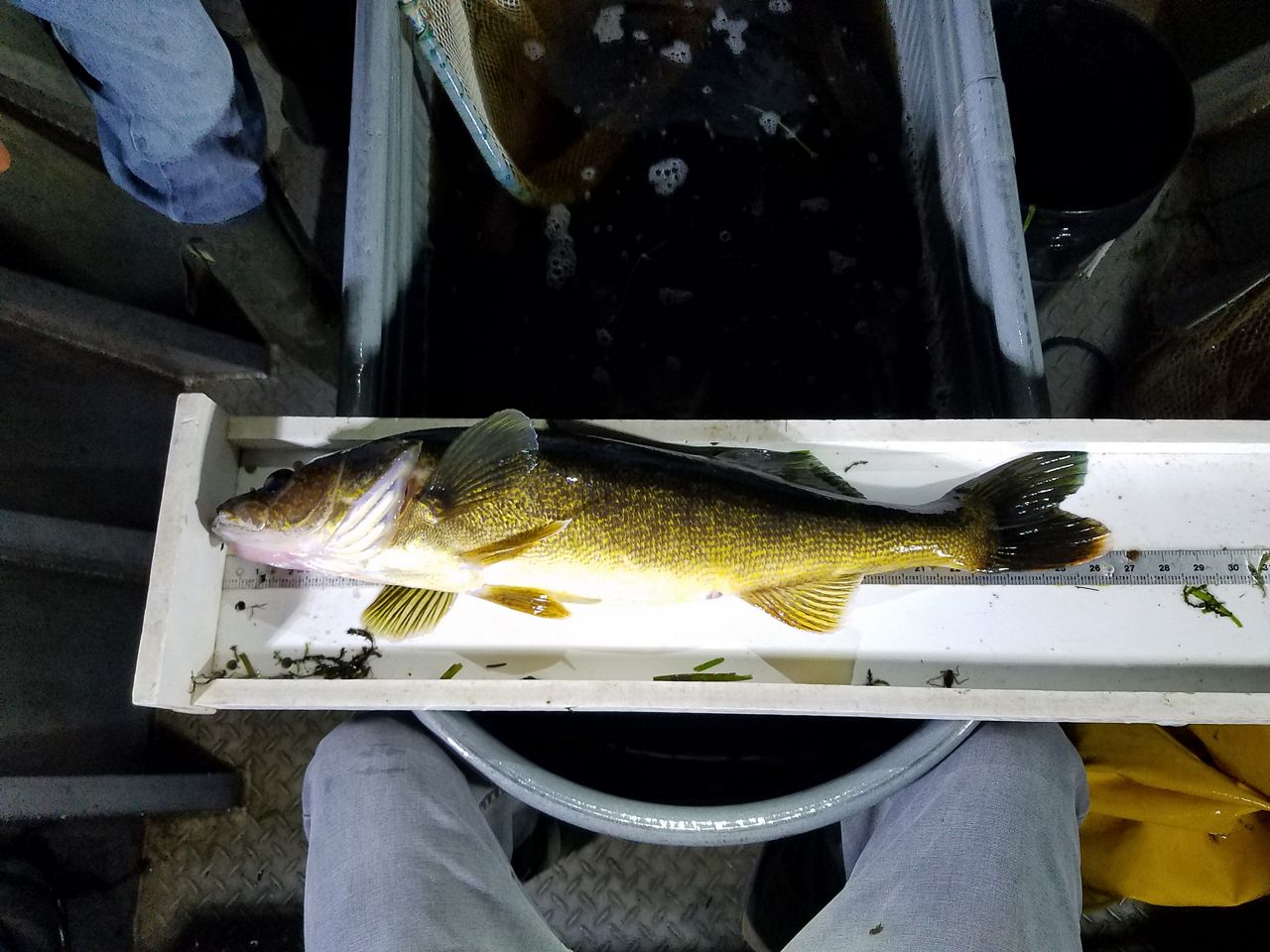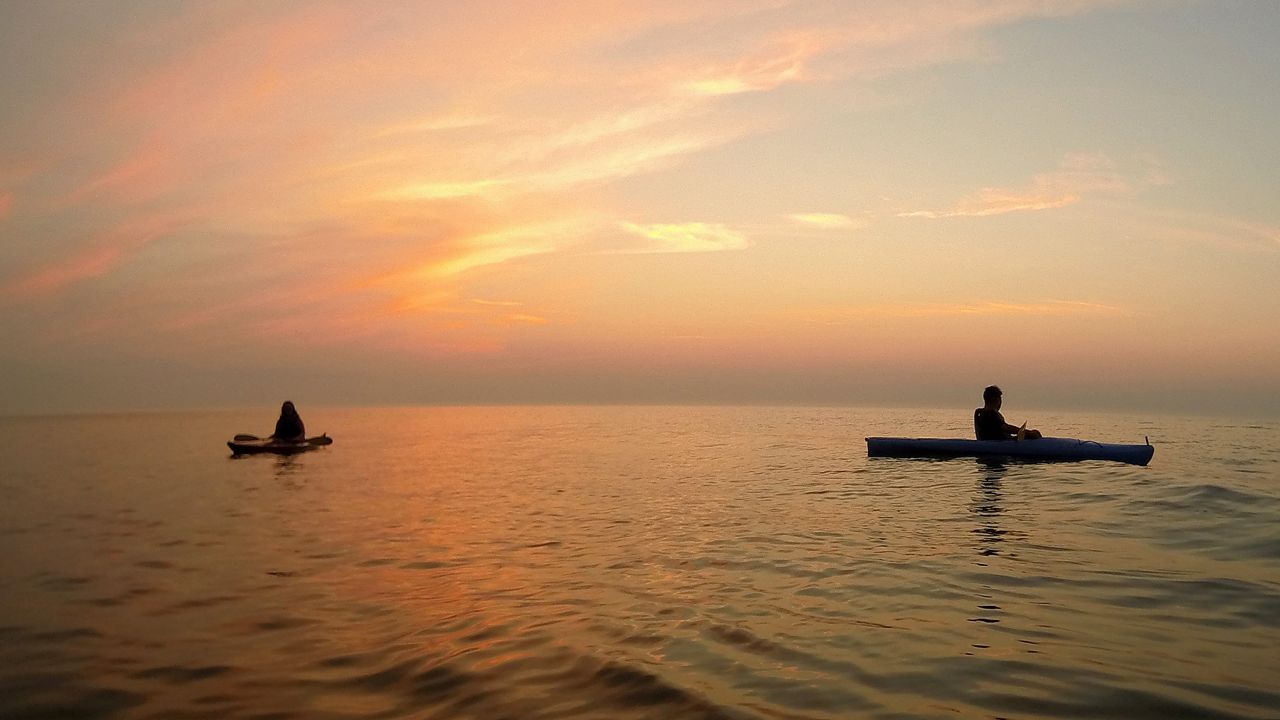This story is part of our Climate Connections series, highlighting how a changing climate is affecting our state.
LAC DU FLAMBEAU, Wis. — Consider the walleye.
With its big, glassy eyes and sharp teeth, the fish has wriggled its way to icon status among Wisconsin’s wildlife. Known as ogaa in the Ojibwe language, the fish has long been a cultural and dietary staple for tribes in the Great Lakes. And for the many anglers casting their lines across the state, the walleye has become a prized catch.
“Walleye is definitely a Wisconsin fish that people think of,” said Titus Seilheimer, fisheries specialist with Wisconsin Sea Grant. “When they go fishing up north, they're fishing for walleye.”
What You Need To Know
- As the weather gets hotter, lake waters are warming too, threatening species like walleye that prefer cool temperatures
- Rising temperatures have wide-reaching effects on lake ecosystems, affecting everything from invasive species to predator-prey interactions
- More precipitation could also lead to extreme highs and lows in water levels, bringing flood and drought concerns
- Groups in the state are working to support species like walleye, while figuring out how much change to accept in our lakes
But the walleyes of today face a big problem. These fish prefer to hang out in cool waters — and as climate change turns up the temperature in Wisconsin, they may lose out on some of that chilly habitat.
They’re far from the only species to be feeling the heat. Across Wisconsin’s more than 15,000 lakes, the impacts of climate change — from temperature shifts to water level extremes — are transforming the ecosystems under the surface, and affecting the humans along the shore.
Lyle Chapman, who has worked as a fishing guide in the Lac du Flambeau area for around 40 years, said he’s “most definitely” noticed changes in the walleye populations.
And while he said “everybody is concerned” about the fish, he’s also hopeful about the many people who are working to care for the lakes — including his son, who works at the tribal hatchery that’s helping replenish fish populations.
“Whether it be tribal members or non-tribal members, everybody gets to use the resources,” Chapman said. “We need to preserve that.”
The Badger State has already seen temperatures tick upwards in recent decades — and the shifts so far are just the beginning, according to predictions from the Wisconsin Initiative on Climate Change Impacts (WICCI).
“Continuing into the future, we’re looking at less ice cover and warmer waters,” Seilheimer said. “So that is going to really impact a lot of species.”
Wisconsin’s lakes have already heated over the decades — a change that’s mostly been observed close to the surface, but sometimes may stretch into deeper waters.
Temperature shifts can have a direct impact on what species can survive, Seilheimer said. Many fish have evolved to live in certain temperature ranges — and if the heat gets cranked up too high, they might start disappearing from lakes where they used to thrive.

That could spell trouble for some important Wisconsin species, explained Aaron Shultz, climate change fisheries biologist with the Great Lakes Indian Fish and Wildlife Commission. Fish like walleye (or ogaa, in Ojibwe); cisco (or adikamig); and lake trout (or namegos) are all better suited to chilly waters, he said.
“Any species that prefers cool water or cold water, they’re going to be more vulnerable than the other beings that prefer warmer habitats,” Shultz said.
Research has found that walleye populations in Wisconsin have already been losing ground in recent decades — while largemouth bass, which are happier in warmer waters, have seen their numbers climb. A GLIFWC report estimated that only 35% of the Wisconsin lakes that support naturally reproducing walleye today will still be able to do so by 2050.
And the direct temperature effects are just one piece of the story. Warming waters can create “cascading impacts” throughout different parts of the ecosystem, said Madeline Magee, the Great Lakes and Mississippi River monitoring coordinator at the DNR.
Some species depend on ice cover to shelter their eggs through the winter until they hatch in the spring, Seilheimer said. But many lakes across the state are seeing shorter periods of ice cover: Magee pointed to Lake Mendota, where the average ice cover period has gotten about a month shorter in the past century.
Climate change could also lead to mismatches between different parts of the food web, Seilheimer pointed out. For example, it might leave fish that hatch at the wrong time without the prey they need to survive.
“Say you’re a whitefish. You’re an incubating egg over the winter, and spring comes around — you’re there, you’re ready, you hatch,” he said. “Is that zooplankton there? You need that food right then.”
Unwanted visitors like invasive species and harmful algal blooms may also be more likely to turn up as lake temperatures rise, Magee added.
In a complicated ecosystem, it's hard to pinpoint what exactly is causing problems, she said. But when climate change interacts with — and possibly intensifies — other stresses to the system, it can become a lot for lakes to deal with.
“If you’re dealing with one stressor, you can usually be kind of resilient to it,” Magee said. “If you’re dealing with two or three or four stressors, it’s a lot harder to juggle everything. Well, that’s the same for a lake, essentially.”
Wisconsin isn’t just becoming warmer. It’s also becoming wetter — and especially seeing more extreme precipitation events, according to WICCI predictions.
“That’s where the future is going to be: More variable and more extreme,” Seilheimer said.
It’s hard to predict exactly how this will affect the water levels in Wisconsin’s lakes, said Katie Hein, lake monitoring technical lead for the DNR.
Extreme rainfall could cause high lake levels and flooding. But hotter temperatures could bring lake levels back down and lead to droughts.
While it’s normal for lakes to see cycles of higher and lower water levels, Hein explained, a future under climate change could make both ends of that spectrum more intense.

“What’s important is for people to be thinking about it from both sides,” said Hein, who is also the chair of the WICCI water resources working group. “Be prepared for highs and be prepared for lows.”
Some ups and downs in lake levels are actually good for lake ecology, Hein said. Wetland plants, for example, grow in shallow water but need dry conditions to germinate.
Too-extreme changes can cause some chaos for species, she said — like when low lake levels in northern Wisconsin left perch’s preferred woody habitat stranded above water. Since the perch had nowhere to hide, bass “had a heyday and ate a ton of perch,” she said, causing the population to crash.
Still, the fluctuating water levels present a problem “more so for the human side,” she said.
One dramatic example comes from Fish Lake in northern Dane County, which has seen a “pretty wild” rise of 17 feet since the 1970s, Hein said. Despite efforts to pump excess water out of the lake, floods still destroyed homes along the shoreline and pushed families to move.
With increasing precipitation, these types of flooding events are looking to become more common, she said. Figuring out how to adapt to those threats — for the lakes’ sake and ours — will be a key part of our climate future.
“It’s not just all doom and gloom,” Hein said. “There’s going to be changes, and how are we going to change with the lakes? And how are we going to help the lakes be resilient to change?”
For many in the state, Wisconsin’s lakes contain something thicker than water.
Hein thinks of the lakes as “the gem of Wisconsin.” Magee pointed out that they’re a part of the culture that connects people throughout the state — across generations, backgrounds and political leanings.
“We don’t necessarily have a ton in common,” Magee said. “But we have our lakes in common.”
That appreciation for our lakes can make it hard to accept how they might change with the climate, Seilheimer said.
A vulnerable species like walleye, for example, isn’t just part of a fishing industry that brings in an estimated $1.9 billion to the economy each year — it also holds a deeper value.
“The tribes have relied on walleye for long, long periods of time. It’s a cultural resource, it’s part of ceremonies, it’s part of feasts,” Shultz said. “And then, on the other side, recreational anglers grew up fishing walleye up here. It’s tradition.”
In the Minocqua chain of lakes, groups including the DNR, GLIFWC, the Lac du Flambeau Band and conservation organizations have worked together to rehabilitate walleye populations, Shultz explained — like by reducing harvests, stocking fish in the lakes and restoring habitat.

But sometimes, that work still feels like “fighting an uphill battle,” he said. In a complex ecosystem, it's hard to pinpoint the specific factors that need to change — like what’s causing a lack of natural reproduction, or why young fish aren’t surviving into adulthood.
After years of work in the Minocqua chain, it’s still unclear whether rehabilitation efforts will bring back a self-sustaining walleye population, Shultz said, though partners are still hopeful they can restore the species.
As the climate transforms, those in Wisconsin and beyond will grapple with these kinds of key questions about how long to keep fighting those battles — and how much change to accept in our waters.
“We have certain expectations for lakes. And that might be, ‘Well, you know, this was a walleye lake, it’s always been a walleye lake, I want it to be a walleye lake,’” Seilheimer said. “That might be a reality where you can’t always have the lake that you want. You have the lake that you have.”
Magee expects that the next 10 to 15 years will only see more changes to the lakes, and to how we’re able to interact with them. Our climate future might place more limits on how we’re able to spend time on the lakes, she pointed out — from ice fishing and snowmobiling to jet skiing and going to the beach.
Keeping the “new normal” of highs and lows in mind will also be important for infrastructure, Hein said, like leaving a natural buffer between homes and the lakefront or building piers that can move with the lakes’ cycles.
To be clear, there are still steps that conservationists and everyday people can take to help our lakes, Magee said. Measures like reducing nutrient runoff, managing invasive species and leaving woody debris for fish to spawn in can help lake ecosystems be more resilient to climate change, she said.
Hein added that leaving nature in place when lake levels drop, instead of rushing in to clean up the beach, can help preserve important habitat. “We need to let nature have some space to move,” she said. And reducing greenhouse gas emissions or taking other steps to slow down climate change will help the lakes, too, Seilheimer pointed out.
For Champan, there’s still a lot of hope that work on the fisheries can help restore the “glory years” of fish in the lakes. And it’s important to try.
“They’ve been here longer than us,” Chapman said. “We have to take care of all of our fish, our wildlife. We’ve got future generations coming up.”



